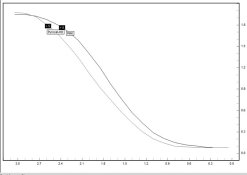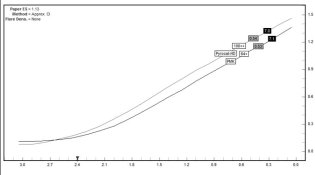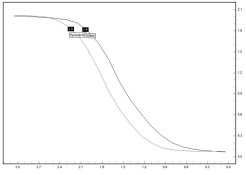sanking
Member
(Long and Technical)
Recently I decided to do some tests with VC papers to provide some concrete information on a couple of issues regarding stained negatives about which there has been considerable speculation but little if any sensitometric data. Two questions were of interest to me.
1. How will a stained negative that is developed to print on a #2 graded silver paper print on a VC paper using a #2 filter?
2. Do PMK and Pyrocat-HD negatives print differently on VC papers.
To answer the first question I selected negatives from previous tests of Ilford FP4+ film developed in Pyrocat-HD and PMK. The negatives selected had a CI of .52, when measured in Blue mode, which is about right for printing on silver graded papers in my conditions.
To test this I first made contact prints with both the PMK and Pyrocat-HD negatives on a #2 Arista graded paper, exposing with the enlarger. The tests were developed in Ansco 130 1:2 for 2:30 minutes.
The resulting prints were virtually identical when adjusted for the slightly higher density of the Pyrocat-HD negatives. I concluded from this that 1) when printing on graded silver papers the reading in Blue mode provides a fairly accurate indicator of paper printing scale, regardless of the color of the stain, and 2) there is little if any difference in the print regardless of which of the two developer one uses.
I then made prints with these same negatives on Arista VC using a #2 filter, same conditions as above. Both prints were very flat and it became obvious that in order to print on the VC papers with the same contrast as on the graded paper I would need to either, 1) use a higher VC filter, or 2) use a negative of much higher CI. After some experimentation I found that a #5 filter was needed with the VC paper to match the result on #2 graded paper. Next I determined how much the CI of the negative would need to be increased so that the #2 graded paper would match a print on VC paper with a #2 filter. Again, after some experimentation I found that a negative CI of .70 was needed to print with the same contrast on VC paper using a #2 filter as a negative with a CI of .52 printed on graded paper.
The curve for these negatives is attached. As you can see, the curves are virtually identical, even though the EFS of Pyrocat-HD at 125 is slightly higher than PMK, which bumps it up slightly on the y-axis.
In order to answer the second of the two questions, i.e. do PMK and Pyrocat-HD negatives print differently on VC papers, I measured the densities of the prints made on VC paper #2 paper (using the PMK and Pyrocat-HD negatives with a CI of .70}. I then plotted the curves, which are attached.
Examination of the curves indicates these differences.
1. The PMK print has a *slightly* longer toe than the Pyrocat-HD print.
2. The Pyrocat-HD print has a longer straight line.
3. The PMK print shows a lot of shouldering, which indicates considerable highlight compression (or compensation).
Persons who understand how negative curves correlate to print values understand that neither curve is superior to the other, though for a given type of film and/or lighting condition one might give better results than the other.
Curves are characteristics of film developers. They are there to be used by people who understand them, but they dont in and for themselves indicate that one developer is superior to another. But they do show important differences that will translate into differences in the tonal values of our prints.
Sandy
Recently I decided to do some tests with VC papers to provide some concrete information on a couple of issues regarding stained negatives about which there has been considerable speculation but little if any sensitometric data. Two questions were of interest to me.
1. How will a stained negative that is developed to print on a #2 graded silver paper print on a VC paper using a #2 filter?
2. Do PMK and Pyrocat-HD negatives print differently on VC papers.
To answer the first question I selected negatives from previous tests of Ilford FP4+ film developed in Pyrocat-HD and PMK. The negatives selected had a CI of .52, when measured in Blue mode, which is about right for printing on silver graded papers in my conditions.
To test this I first made contact prints with both the PMK and Pyrocat-HD negatives on a #2 Arista graded paper, exposing with the enlarger. The tests were developed in Ansco 130 1:2 for 2:30 minutes.
The resulting prints were virtually identical when adjusted for the slightly higher density of the Pyrocat-HD negatives. I concluded from this that 1) when printing on graded silver papers the reading in Blue mode provides a fairly accurate indicator of paper printing scale, regardless of the color of the stain, and 2) there is little if any difference in the print regardless of which of the two developer one uses.
I then made prints with these same negatives on Arista VC using a #2 filter, same conditions as above. Both prints were very flat and it became obvious that in order to print on the VC papers with the same contrast as on the graded paper I would need to either, 1) use a higher VC filter, or 2) use a negative of much higher CI. After some experimentation I found that a #5 filter was needed with the VC paper to match the result on #2 graded paper. Next I determined how much the CI of the negative would need to be increased so that the #2 graded paper would match a print on VC paper with a #2 filter. Again, after some experimentation I found that a negative CI of .70 was needed to print with the same contrast on VC paper using a #2 filter as a negative with a CI of .52 printed on graded paper.
The curve for these negatives is attached. As you can see, the curves are virtually identical, even though the EFS of Pyrocat-HD at 125 is slightly higher than PMK, which bumps it up slightly on the y-axis.
In order to answer the second of the two questions, i.e. do PMK and Pyrocat-HD negatives print differently on VC papers, I measured the densities of the prints made on VC paper #2 paper (using the PMK and Pyrocat-HD negatives with a CI of .70}. I then plotted the curves, which are attached.
Examination of the curves indicates these differences.
1. The PMK print has a *slightly* longer toe than the Pyrocat-HD print.
2. The Pyrocat-HD print has a longer straight line.
3. The PMK print shows a lot of shouldering, which indicates considerable highlight compression (or compensation).
Persons who understand how negative curves correlate to print values understand that neither curve is superior to the other, though for a given type of film and/or lighting condition one might give better results than the other.
Curves are characteristics of film developers. They are there to be used by people who understand them, but they dont in and for themselves indicate that one developer is superior to another. But they do show important differences that will translate into differences in the tonal values of our prints.
Sandy
Attachments
Last edited by a moderator:














